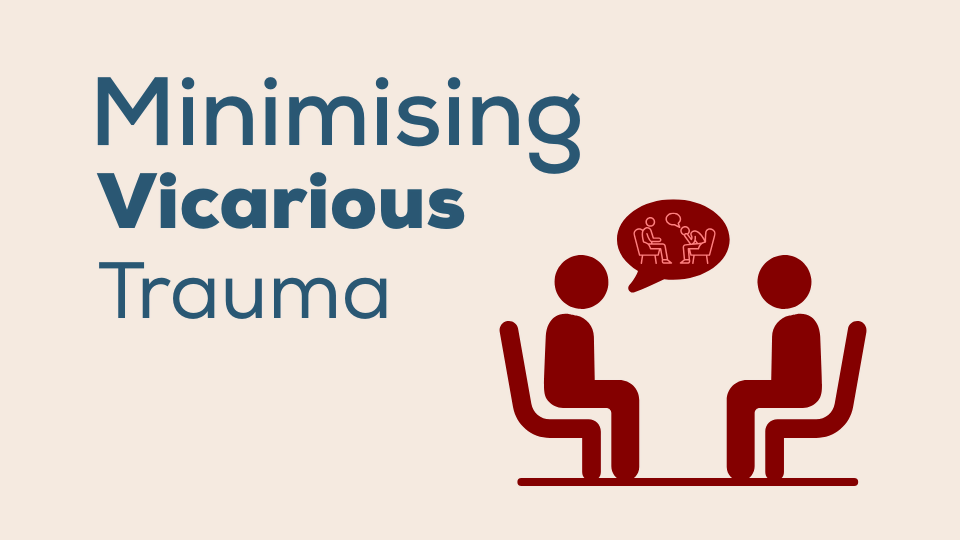What is Vicarious Trauma?
Vicarious trauma is the emotional and psychological impact experienced by those in helping professions as a result of exposure to their clients’ traumatic experiences. It is typically experienced as a state of exhaustion and dysfunction, biologically, physiologically and emotionally, as a result of prolonged exposure to compassion stress.
The risk of developing vicarious trauma can be influenced by the nature and context of the trauma, the psychologist’s own personal history, values and beliefs, the dynamics of the helping relationship, and the nature of the therapeutic work. When left unrecognised or unaddressed, vicarious trauma can lead to prolonged emotional and psychological strain. This strain can impair professional judgment, increase risk of burnout or compassion fatigue, and affect personal well-being and impairments in clinical judgment.
Supervision plays a crucial role in helping supervisees recognise and manage these impacts by providing a safe space to reflect on their experiences, acknowledge their distress, explore countertransference, and develop professional boundaries. Protecting supervisees from vicarious trauma supports their resilience, maintains their effectiveness in therapeutic roles, and ensures ethical, competent care for clients. It also fosters their personal and professional growth and supports longevity in their profession.
How can supervisors support to minimise the impact of vicarious trauma?
Supervisors can support their supervisees to minimise the impact of vicarious trauma through several strategies:
1. Acknowledging and addressing distress
Encourage supervisees to recognise and acknowledge their distress related to trauma work. By acknowledging the challenges associated with this field of work and validating their human responses of distress, this creates space for authenticity and exploration. It may also be helpful to provide gentle education around the realities of abuse, trauma impact, and the needs of traumatised clients.
2. Identifying and managing empathic responses to client’s trauma experiences
Assist supervisees to become aware of and manage various empathic reactions which may involve: withdrawing emotionally or intellectualising clients’ trauma, over-identification of client’s traumatic experiences, fluctuating between withdrawal and over-involvement or unprocessed emotional responses. Supervisors should help supervisees by identifying theseempathic responses, set professional boundaries, and recognise the role of countertransference. In addition, it may be helpful to explore countertransference responses that may be clouding clinical judgement, leading to heightened emotional responses from supervisees or blurring professional roles and boundaries.
3. Creating a safe supervisory space
Supervision should be a space that allows supervisees to bring their professional queries and concerns so that they can be explored collaboratively and openly. Supervisors should enable a supportive environment where supervisees can reflect on their experiences, discuss ethical dilemmas, and explore emotional and professional challenges related to trauma work.
4. Promoting self-care
Encourage supervisees to regularly and consistently practice self-care. This involves both proactive behavioural habits as well as mental shifts in the scope and limits of one’s clinical role. This may also involve attending to their own emotional and spiritual needs, and take breaks from trauma exposure when necessary to prevent burnout or compassion fatigue.
Supervisors should also be good role models by demonstrating their own self care practices. This may include ongoing professional reflexivity and honest self-assessment around one’s own capabilities and limits and seeking peer supervision when needed.
5. Clarifying roles and boundaries
Model and reinforce the importance of maintaining clear professional boundaries with clients and within the therapeutic relationship, helping supervisees avoid overinvolvement, enmeshment and countertransference.
6. Competency-based support and reflection
Supervisees, particularly those new to the field may require further training and support to build on specific competencies. Supervisors can use competency-based supervision to build supervisees’ skills and resilience, including reflective practice to foster self-awareness about their emotional responses and rationale for clinical decisions.
7. Advocacy and organisational support
Ensure supervisees access organisational supports, adhere to relevant protocols, and receive training that supports trauma-informed practice.
In summary, vicarious trauma is an important area to address when supervising psychologists working in high risk populations. By safeguarding supervisees from vicarious trauma and minimising the impact of compassion fatigue, supervisors play a pivotal role in supporting effective self-care and reflexive practices and ongoing effectiveness and satisfaction of their supervisees in the rewarding yet demanding profession of psychology.
To learn more about supervising in high risk populations, attend our upcoming supervisor masterclass.
References
- Etherington, K. (2009). Supervising helpers who work with the trauma of sexual abuse. British Journal of Guidance & Counselling, 37, 179 – 194.
- Hoffman, R.M., Osborn, C.J. & West. J.D (2013). Clinical Supervision of Counselors-in-Training Working with Suicidal Clients: A Grounded Theory Investigation. The Clinical Supervisor, 32(1), 105-127, DOI: 10.1080/07325223.2013.780991


